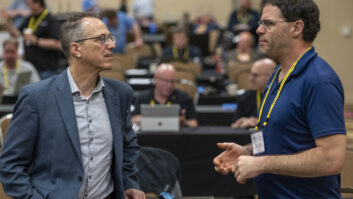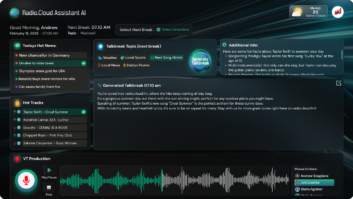As part of our on-going series, we present four questions to authors of the recent 11th�edition of the NAB Engineering handbook. This time, it�s David Maxson of Isotrope, regarding chapter 10.2.
�
Radio magazine: David, you�ve a long history in broadcasting, but your current company provides services in many different aspects of wireless communications. Would you describe a few of Isotrope�s projects outside of broadcasting?
David Maxson: In addition to our ongoing support for several radio stations in Massachusetts, Isotrope looks for special projects that allow us to use our RF, networking, telecom and systems design skills in and out of the broadcasting arena. Isotrope recently designed a network of about 90 trackside antenna sites in Pennsylvania, Delaware and Maryland to provide internet connectivity to Amtrak trains on that section of the Northeast Corridor. That initial network segment is currently under construction. We recently helped a resort with two campuses in Massachusetts develop an on-campus and intercampus fiber optic backbone for its operational and guest-facing networks, plus improve its WiFi service to guests. Our background in broadcast engineering enables Isotrope to integrate the array of specialties required for such projects: system design, value engineering, RF, IT, test/measurement, permitting, code compliance and construction experience.
Radio: Your NAB Engineering Handbook 11th�edition chapter 10.2 goes in to detail about equipment performance measurements for AM radio. To those that have the test equipment and time and inclination to take EPMs for their own AM station, what would you say is the most easily avoidable mistake?
Maxson: I have to chuckle at �easily avoidable mistakes� in AM broadcast measurements. Despite AM broadcasting�s status as the primordial legacy technology, it is still a very complicated thing to pull off. The most easily avoidable mistake might be to be sure you have charged batteries and/or a clean mobile power supply for your field measurement equipment. It is nice to get a field measurement effort off on the right foot by arriving at a measurement spot with equipment that is ready to go.
Radio: For those taking 73.44 measurements for a directional AM, what (if any) is the rule-of-thumb for choosing the actual measurement location?
Maxson: This is the $50,000 question, and the reason I was asked to research and write this chapter of the NAB Engineering Handbook. The FCC was confronted with a perplexing problem to define directional AM emissions limits. Do you look at the main lobe of the pattern, the side of the pattern or the back of the pattern for undesirable emissions from the array? What should the reference level of the measurement be? On the main lobe, the array has gain, which could artificially elevate the signal-to-interference ratio in the station�s favor. Off the main lobe, the opposite could be true � the arbitrarily low main signal level could be a disadvantage for the station. The FCC decided to use the station�s reference non-directional field strength at 1 km. There are alternatives available and there are a couple of ways to use the rule to select a spot in the field. This chapter gives the broadcast engineer the tools to get AM EPM measurements that conform to the letter of the law.
Radio: Your chapter also covers spectrum analyzer requirements for those that want to take spectrum mask measurements for AM IBOC. Can you suggest a few SA models that are suited for the job?
Maxson The chapter explains what to look for in a spectrum analyzer. Some analyzers are rather noisy below 10 MHz, so you need to look at the specs for good noise performance at AM frequencies, or try out an analyzer before committing to it. If your reference level (received level of your AM signal under test) is too close to the instrument�s noise floor, you may not be able to tell if the station complies with the RF mask. The chapter covers the key analyzer parameters of Dynamic Range, Displayed Average Noise Level, Third-Order Intermodulation, 1 dB Compression and Phase Noise. If the analyzer you are considering has marginal specs in any of these categories, or has vague or undisclosed specs at AM frequencies, it is wise to look elsewhere. If you don�t take the time to get a basic understanding of how these specs affect your work, you probably should not be making measurements to validate FCC compliance.�
�







